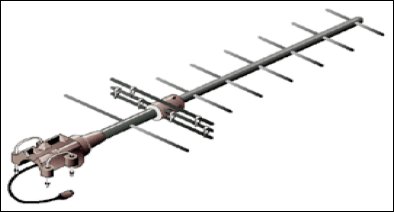| Wireles Networking is a practical guide to planning and building low-cost telecommunications infrastructure. See the editorial for more information.... |

|

Home  Antennas and Transmission Lines Antennas and Transmission Lines  Antennas Antennas  Types of Antennas Types of Antennas  Yagi Antenna Yagi Antenna |
|||
| See also: 1/4 Wavelength Ground Plane | |||






|
|||
|
Yagi AntennaA basic Yagi consists of a certain number of straight elements, each measuring approximately half wavelength. The driven or active element of a Yagi is the equivalent of a center-fed, half-wave dipole antenna. Parallel to the driven element, and approximately 0.2 to 0.5 wavelength on either side of it, are straight rods or wires called reflectors and directors, or simply passive elements. A reflector is placed behind the driven element and is slightly longer than half wavelength; a director is placed in front of the driven element and is slightly shorter than half wavelength. A typical Yagi has one reflector and one or more directors. The antenna propagates electromagnetic field energy in the direction running from the driven element toward the directors, and is most sensitive to incoming electromagnetic field energy in this same direction. The more directors a Yagi has, the greater the gain. As more directors are added to a Yagi, it therefore becomes longer. Following is the photo of a Yagi antenna with 6 directors and one reflector.
Yagi antennas are used primarily for Point-to-Point links, have a gain from 10 to 20 dBi and a horizontal beamwidth of 10 to 20 degrees.
|
|||
Home  Antennas and Transmission Lines Antennas and Transmission Lines  Antennas Antennas  Types of Antennas Types of Antennas  Yagi Antenna Yagi Antenna |
|||
Last Update: 2007-01-24


